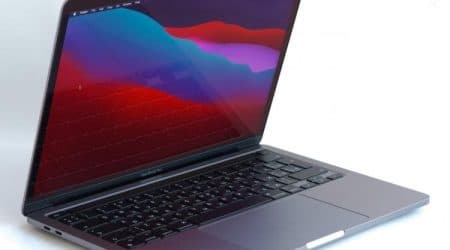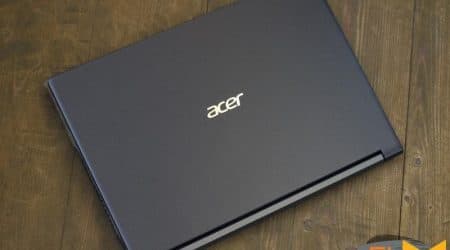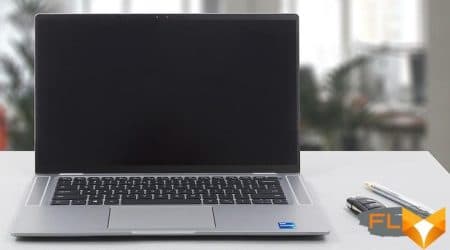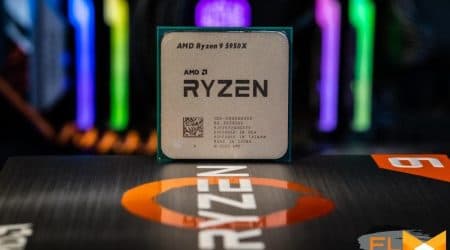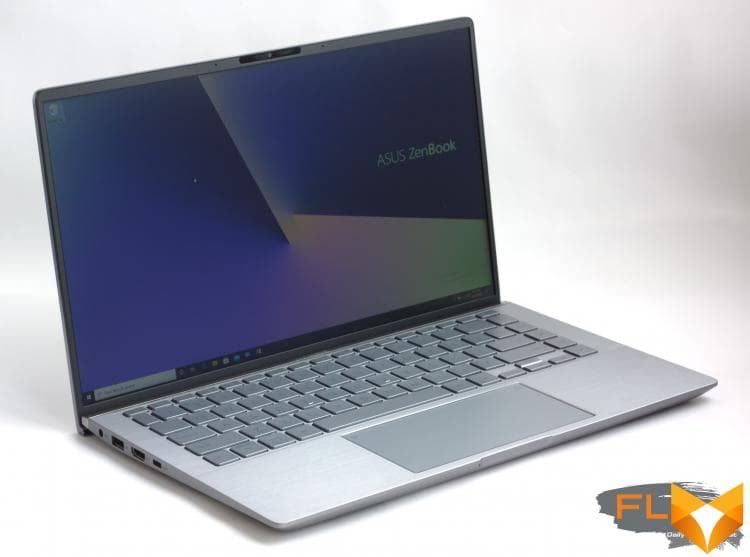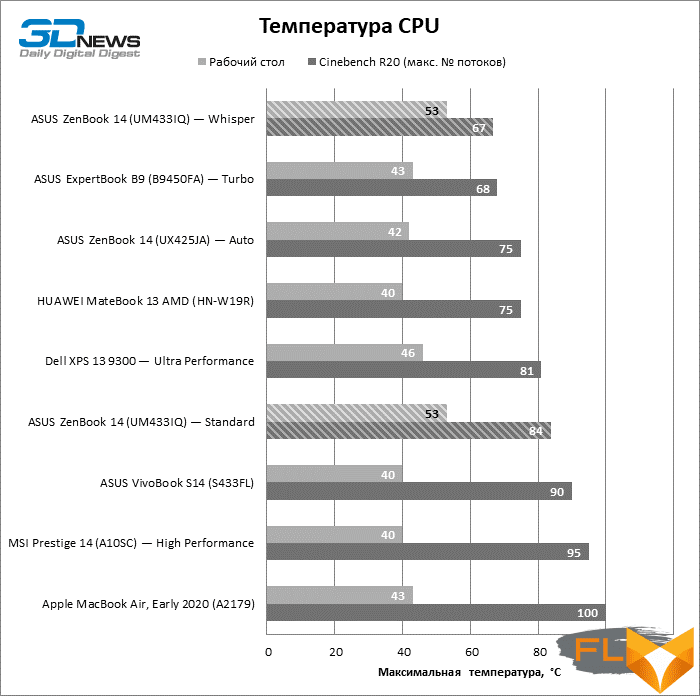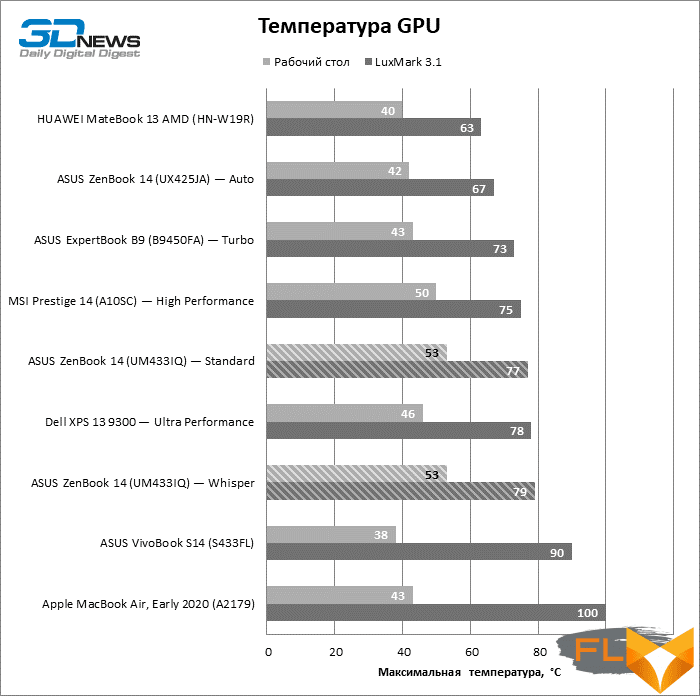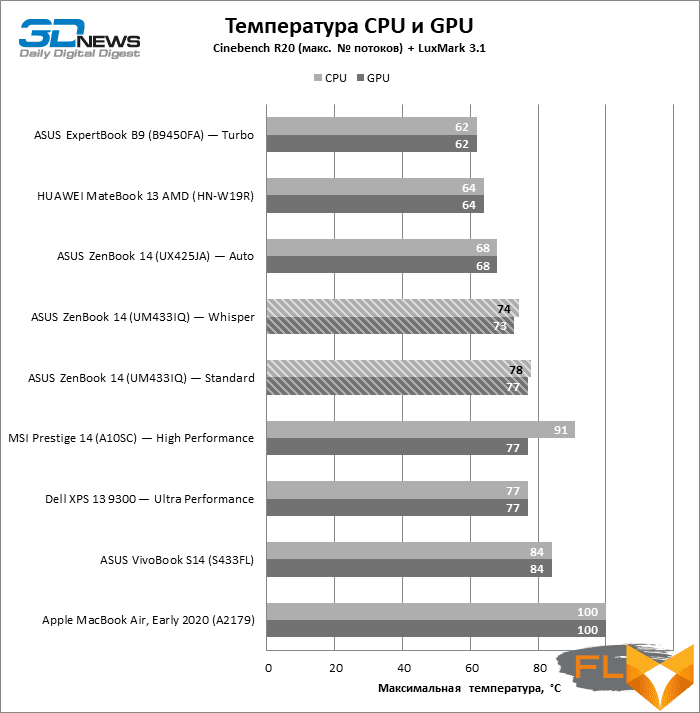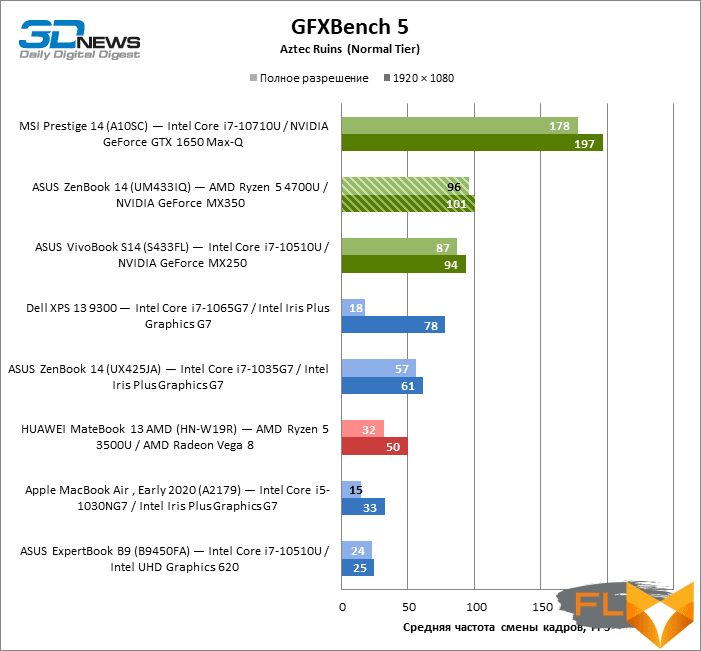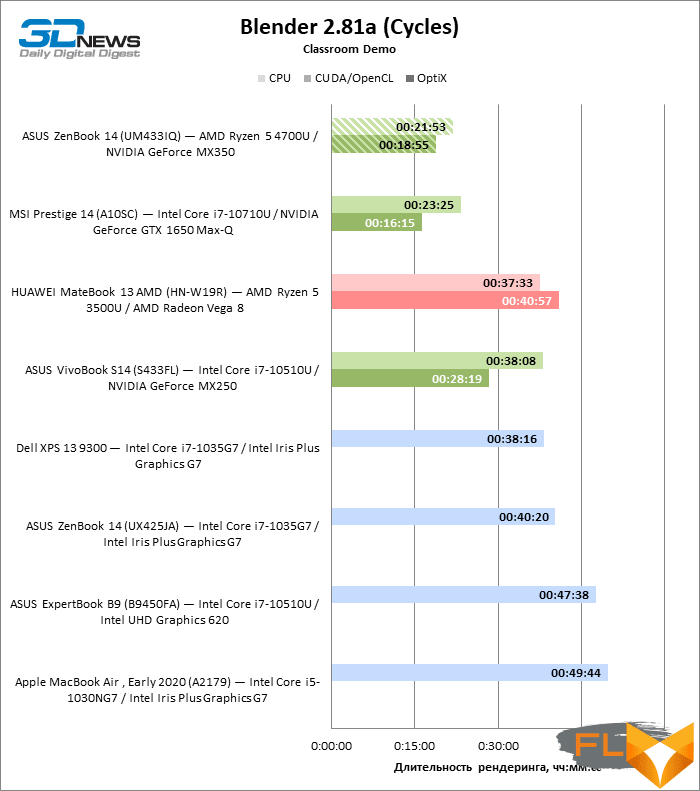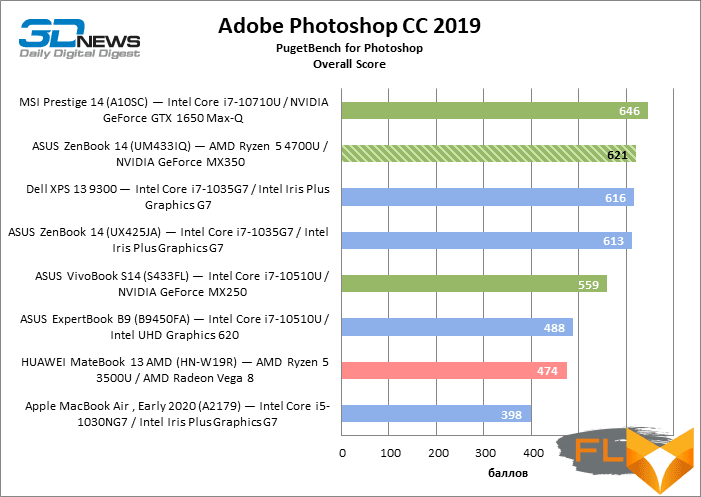


The ASUS ZenBook 14 UM433IQ is the first Ryzen 4000-series business laptop since the HP ProBook 455 G7. But if the ProBook was some sort of pure Ryzen 4000 lab testbed (a spacious chassis and a low-power six-core CPU), then the ASUS ZenBook 14 will be a real test of quality for the “red” processors of the new generation. Whatever one may say, eight cores in a thin and light body is a big step forward for compact ultrabooks, but at the same time a big responsibility. The manufacturer will have to prove that additional cores, firstly, are useful in standard tasks that such computers are loaded with, and secondly, they do not burden the cooling system beyond measure. With Ryzen 4000, the laptop should get faster, but not at the cost of high noise levels or overheating components. Let’s check whether ASUS managed to implement these theses in practice – or eight-core CPUs still require special treatment, despite AMD’s achievements in chip energy efficiency.
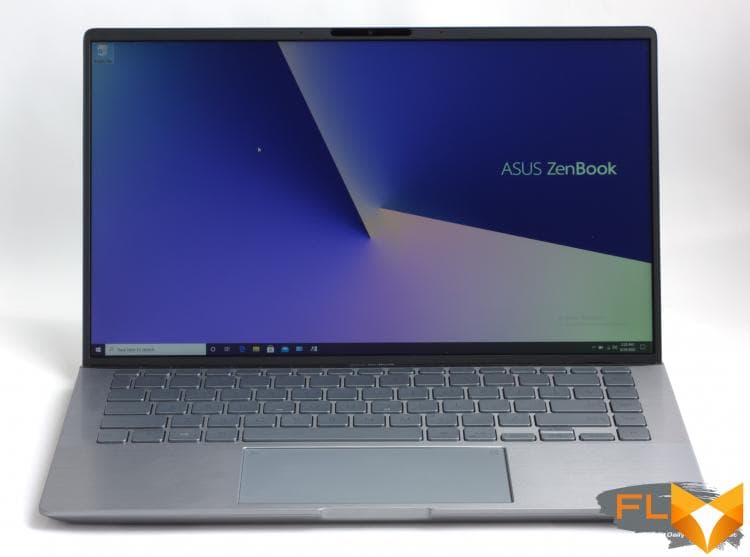
⇡#Specifications, prices
Speaking about the specifications of ASUS ZenBook 14 UM433IQ, we will build a story not as usual, first voicing the list of components and then the cost, but vice versa. What hardware is now installed in most laptops priced between $1,000 and $1,300? If we are talking about products with Intel chips inside, then most often it is a quad-core processor on the Comet Lake or Ice Lake core, 8 GB of system memory and a 256 or 512 GB SSD. The graphics in such a laptop will either be integrated – if we take devices in the lower part of the price range, or it will turn out to be a discrete entry-level chip, if we consider laptops closer to the upper limit we have drawn.
How about getting six cores for less than $1,000? This is the junior configuration of the ZenBook 14 UM433IQ based on the Ryzen 5 4500U, and it is already beyond the limits available on the Ice Lake ultrabook platform, not only in terms of price, but also in terms of technical capabilities, because Intel simply does not produce such six-core processors. In turn, the ZenBook 14 UM433IQ model, intermediate in most characteristics, but already with an eight-core Ryzen 7 4700U processor, is available at a minimum price of $ 1,300, while Intel’s eight-core processors on 10th generation Core chips are not presented either in the budget or ultra-compact sector. And on top of that, any modifications of the UM433IQ are equipped with GeForce MX350 discrete graphics, which, of course, does not apply to gaming solutions, but allows you to run undemanding games and helps the central processor in work tasks.
| Manufacturer | ASUS |
|---|---|
| Model | ASUS ZenBook 14 (UM433IQ) |
| Display | 14”, 1920 × 1080 (60Hz), IPS |
| CPU | AMD Ryzen 5 4500U (6/6 cores/threads, 2.3-4.0 GHz); AMD Ryzen 7 4700U (8/8 cores/threads, 2.0-4.1 GHz) |
| RAM | LPDDR4X SDRAM, 4266 MHz, 8/16 GB (two channels) |
| GPU | NVIDIA GeForce MX350 (2GB GDDR5) |
| Drive | SSD (PCI Express 3.0 x2) 256/512 GB; SSD (PCI Express 3.0 x4) 1024GB |
| External I/O connectors | 1 × USB 3.2 Gen 2 Type-C; 1 x USB 3.2 Gen 2 Type-A; 1 x USB 2.0; 1 x HDMI; 1x microSD; 1 × TRS 3.5mm |
| Сеть | IEEE 802.11ax + Bluetooth 5.0 |
| Battery capacity | 50 Wh |
| Mass | 1.15 kg |
| Overall dimensions (L × H × D), mm | 319 × 199 × 16.9 |
| Retail price | From $1000 (Ryzen 5 4500U 8GB SSD 256GB) From $1300 (Ryzen 7 4700U 8GB 512GB SSD) |
Needless to say, the proposals that arose on the laptop market thanks to the Ryzen 4000 series processors, although they were rather delayed after the announcement of the chips themselves back in January of this year, they look outrageous in a good way. And if in higher price categories the advantage of AMD is set off by the difference between the systems in other components, then among inexpensive ultrabooks, red is confidently coming into fashion. But before we move on to the long-awaited performance tests, let’s make sure that AMD’s mobile processors, as in the past, did not let down the frankly cheap design and chassis construction.
⇡#Look and Ergonomics
A superficial look at the ZenBook 14 UM433IQ was enough to dispel any fears inspired by memories of APU-based laptops from the “pre-Rise” era. This car both looks and is made with high quality, even with a certain claim to premium. In terms of dimensions, this is a typical modern ultrabook, the dimensions of which in length and width set the parameters of a 14-inch screen matrix with thin frames around. The novelty is even smaller compared to the ZenBook 14 UX425JA model on the Intel platform due to the fact that the high “chin” was removed from under the screen. Surprisingly, this is what a laptop with an eight-core processor looks like today. The “blue” version of the ZenBook 14 has one advantage in design – it is 3 mm thinner, but the machines weigh almost the same: 1.13-1.15 kg.
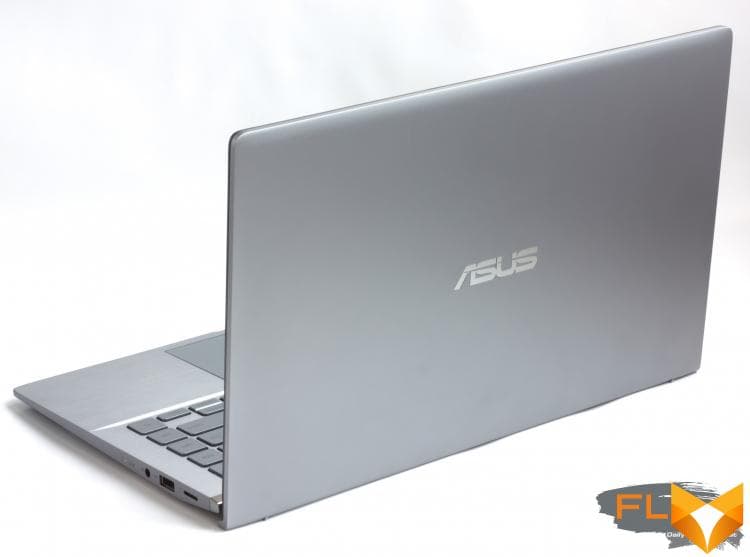
The ZenBook 14 UM433IQ’s body panels are all made of gray aluminum, and the surface around the keyboard and touchpad has a brushed texture that perfectly hides fingerprints. As usual with ASUS, the laptop designers put the weight of the device at the forefront, trying to make it as light as possible, so the chassis walls are quite thin here. Even so, we were pleased to find that the screen cover wasn’t too easy to push down the middle or bend with a screw, and the bottom chassis block was stronger than other lightweight ultrabooks. And yet, when typing on the keyboard, it feels like it lacks support.
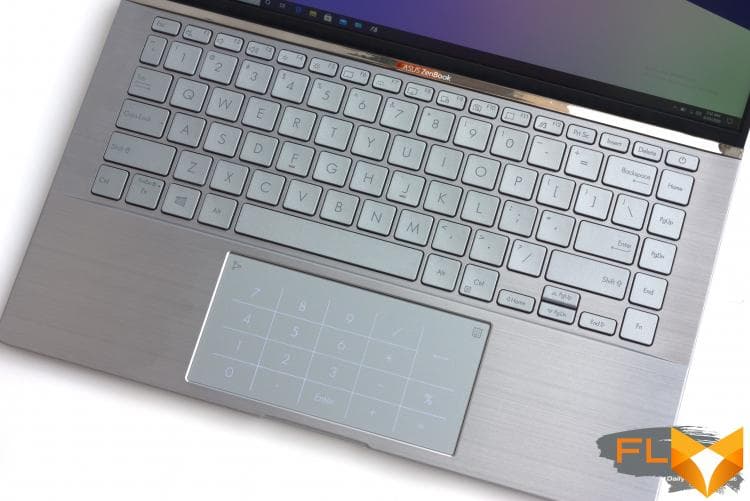
As for the controls themselves, the ZenBook 14 UM433IQ got a slightly different keyboard than the UX425JA. The laptop on Ryzen has exactly the same set of keys as the related Intel model, but for some reason it was already made, sacrificing the width of the function keys and the left row of the main ones. In addition, the keycaps are painted in the same gray color as the body panels, and this does not help at all to distinguish the symbols in the light, unless you turn off the white LED backlight. The mechanics of the keys are satisfactory: they have a fairly long travel and give a clear tactile response, but the cones under the keys do not return to their neutral position as quickly as the best laptop keyboards. However, when printing fast on the ZenBook 14 UM433IQ, it’s not at all annoying, but the lack of rigidity in the laptop chassis.
In many mobile PCs, including the UM433IQ, ASUS uses a touchpad with a “virtual” numeric keypad that turns on and off on demand. We once again made sure that the markup is perfectly visible even in very bright daylight (the number pad is even brighter than the characters on the physical keys) and that it absolutely does not interfere with the use of the touchpad for its intended purpose. The only reason for complaints was the mechanics of the touchpad: the panel is not fixed in the best way in the neutral position, and it is easy to push it through until the switch is activated, especially in the corners.

Having learned that the new ASUS laptop uses AMD central processors, experienced readers will probably immediately understand what is definitely not in it. Of course, Thunderbolt ports, although for the kind of money that the ZenBook 14 UM433IQ costs, you can’t count on their presence in any case. As a result, the laptop is charged from a voltage regulator with an ordinary barrel plug. But ASUS used the entire limited area on the sides of the case with maximum benefit: in addition to two USB Type-A ports, there was a place for Type-C, full-format HDMI and – hooray! – microSD card reader.
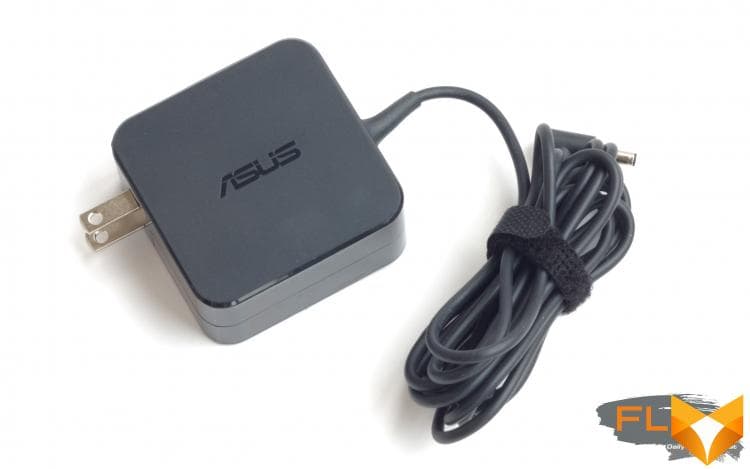
Finally, another sign that the ZenBook 14 UM433IQ is still aimed at the budget conscious buyer is the quality of the built-in speaker system. It sounds quite loud, but let us not be upset because of the lack of full-fledged bass, the nasty pain at high frequencies is no longer the norm even for integrated speakers.
⇡#Internal design and upgrade options
The high energy efficiency of the new AMD processors has made it much easier for laptop designers to remove heat from the CPU. But, as we will have time to see, the top models of ZenBook 14 UM433IQ with eight-core chips on board will not be damaged by any means that enhance cooling efficiency. ASUS once again uses the beloved arched design of the chassis, when the back of the case rests on the protrusion of the screen cover in the working position. As a result, the bottom rises above the table, and the cooler sucks air through the grate from below.
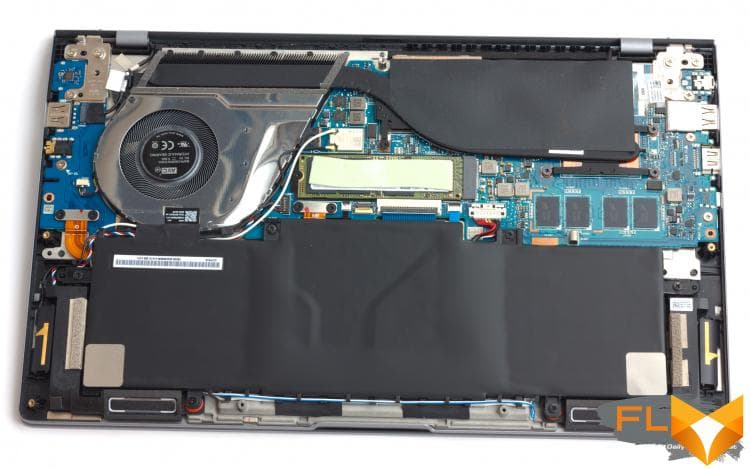
Only the SSD can be upgraded inside the UM433IQ, since the RAM chips are soldered directly on the motherboard, so we recommend choosing a laptop configuration for growth, with 16 GB of RAM.
⇡#Test Methodology
| Synthetic tests | |
|---|---|
| Application | Settings |
| 3DMark Time Spy | — |
| Geekbench 4 | — |
| CINEBENCH R20 | — |
| GFXBench 5 (Aztec Ruins — Normal Tier, High Tier) | Windows: Vulkan, macOS: Metal |
| fio 3.16 | Sequential read/write, random read/write (unbuffered I/O) |
| Working Applications | |||||
|---|---|---|---|---|---|
| Application | Benchmark | Settings | API | ||
| Intel Graphics | AMD Graphics | NVIDIA Graphics | |||
| Adobe Photoshop CC 2019 | PugetBench for Photoshop CC 0.8 (linked test structure) | Basic Benchmark | OpenGL + OpenCL + Metal (macOS) | OpenGL + OpenCL + Metal (macOS) | OpenGL + OpenCL |
| Adobe Photoshop Lightroom Classic CC 2020 | PugetBench for Lightroom Classic 0.8 (test structure at link) | — | DirectX 12 (Windows) | DirectX 12 (Windows) | DirectX 12 |
| Adobe Premiere Pro CC 2019 | PugetBench for Premiere Pro 0.8 (linked test structure) | Standard Benchmark | OpenCL (Windows)/Metal (macOS) | OpenCL (Windows)/Metal (macOS) | CUDA |
| Blender 2.81a | Class Room demo from Blender Foundation | Cycles renderer. Feature Set: Supported. Tile size: 32 × 32 (CPU) or 256 × 256 (GPU) | N/A (CPU rendering) | OpenCL | CUDA/OptX |
| AMD Nissan GTR Demo | Radeon ProRender | N/A | OpenCL | OpenCL | |
Display testing is performed using a Datacolor Spyder4 Elite colorimeter in ArgyllCMS and DisplayCAL 3 applications.
Notebook battery life is measured at a display brightness of 200 cd/m2in the following usage scenarios:
- web surfing: alternately opening and closing tabs of Computeruniverse.ru and Unsplash.com sites with an interval of 25 seconds in the Google Chrome browser (cache and cookies are disabled);
- Continuous playback of 4K HEVC (H.265) video.
⇡#Test participants
The following devices took part in testing:
| Screen | CPU | RAM | GPU | SSD | HDD | Battery | |||
|---|---|---|---|---|---|---|---|---|---|
| ASUS ZenBook 14 (UM433IQ) | 14”, 1920 × 1080, IPS | AMD Ryzen 7 4700U | 8/8 cores/threads, 2.0-4.1 GHz | LPDDR4X SDRAM, 4266 MT/s, 16 GB | NVIDIA GeForce MX350 | 2GB GDDR5 | Samsung PM981 (PCIe 3.0 x4) 1024 GB | No | 50 Wh |
| Apple MacBook Air, Early 2020 (A2179) | 13,3”, 2560 × 1600, IPS | Intel Core i5-1030NG7 | 4/8 cores/threads, 1.1-3.5 GHz | LPDDR4X SDRAM, 3733 MT/s, 8 GB | Intel Iris Plus Graphics G7 | 1.5 GB of system RAM | Apple AP0512N (PCIe 3.0 x4) 512GB | No | 49.9 Wh |
| ASUS ExpertBook B9 (B9450FA) | 14”, 1920 × 1080, IPS | Intel Core i7-10510U | 4/8 cores/threads, 1.8-4.9 GHz | LPDDR3 SDRAM, 2133 MT/s, 16 GB | Intel UHD Graphics 620 | ~1 GB of system RAM | 2 × Samsung PM981 (PCIe 3.0 x4) 1024 GB | No | 66 Wh |
| ASUS VivoBook S14 (S433FL) | 14”, 1920 × 1080, IPS | Intel Core i7-10510U | 4/8 cores/threads, 1.8-4.9 GHz | DDR4 SDRAM, 2666 MT/s, 16 GB | NVIDIA GeForce MX250 | 2GB GDDR5 | Samsung PM981 (PCIe 3.0 x4) 1024 GB | No | 50 Wh |
| ASUS ZenBook 14 (UX425JA) | 14”, 1920 × 1080, IPS | Intel Core i7-1035G7 | 4/8 cores/threads, 1.2-3.7 GHz | LPDDR4X SDRAM, 3200 MT/s, 16 GB | Intel Iris Plus Graphics G7 | System RAM | Micron 2200 (PCIe 3.0 x4) 1024 GB | No | 67 Wh |
| Dell XPS 13 9300 | 13.4″, 3840 × 2400, IPS | Intel Core i7-1065G7 | 4/8 cores/threads, 1.2-3.7 GHz | LPDDR4X SDRAM, 3733 MT/s, 16 GB | Intel Iris Plus Graphics G7 | System RAM | KIOXIA XG6 (PCIe 3.0 x4) 512 GB | No | 52 Wh |
| HUAWEI MateBook 13 AMD (HN-W19R) | 13″, 2160 × 1440, IPS | AMD Ryzen 5 3500U | 4/8 cores/threads, 2.1-3.7 GHz | DDR4 SDRAM, 3733 MT/s, 16 GB | AMD Radeon Vega 8 | 1 GB of system RAM | WD PC SN730 (PCIe 3.0 x4) 512 GB | No | 41.8 Wh |
| MSI Prestige 14 (A10SC) | 14”, 1920 × 1080, IPS | Intel Core i7-10710U | 6/12 cores/threads, 1.1-4.7 GHz | LPDDR3 SDRAM, 2133 MT/s, 16 GB | NVIDIA GeForce GTX 1650 Max-Q | 4GB GDDR6 | Samsung PM981 (PCIe 3.0 x4) 1024 GB | No | 52 Wh |
⇡#Screen Quality
The new ASUS ZenBook 14 on the AMD platform got a screen matrix with quite typical (and therefore far from outstanding compared to the best samples) characteristics for ultrabooks of this form factor and price category. In tests, it showed a satisfactory brightness – 268 cd/m2 – with a very mediocre contrast ratio of 653:1.
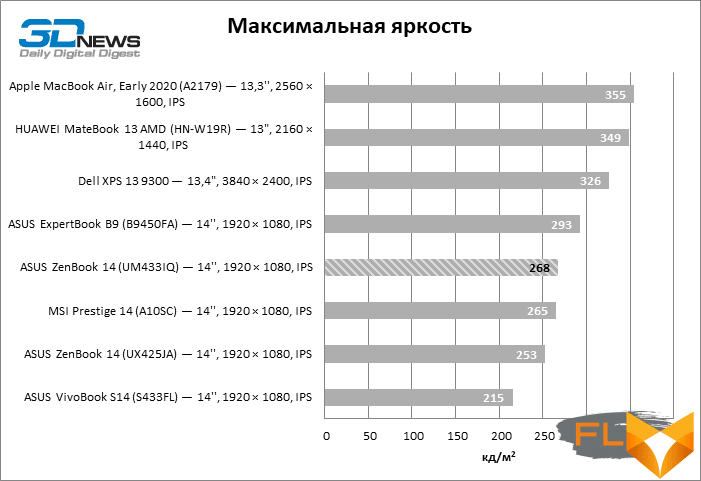
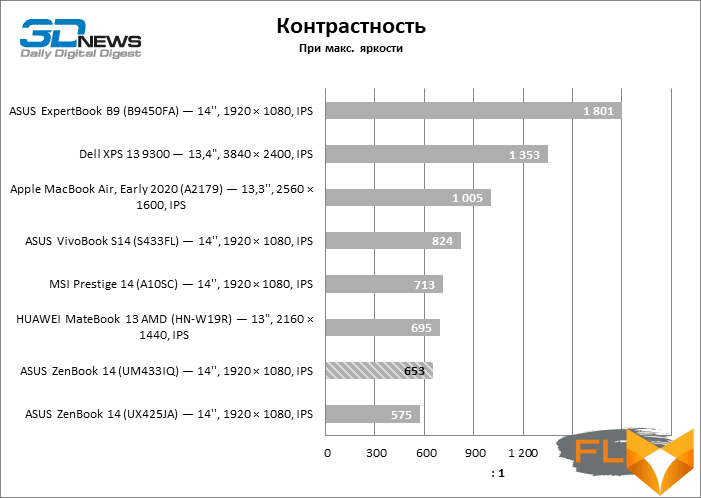
Of course, the screen has not been calibrated, and the laptop does not come with an ICC profile that applications with their own color management system could use. This is clearly seen, for example, in the color temperature increased to 7500 K.
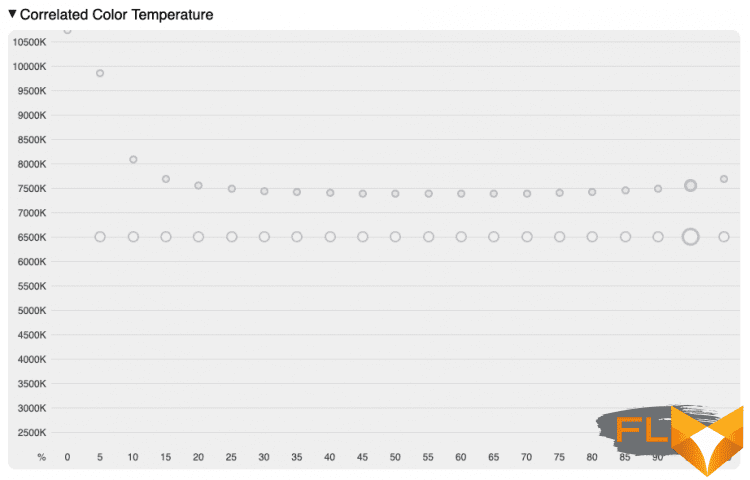
Be that as it may, the ZenBook 14 UM433IQ can still be adapted to work with photographs if the user performs the matrix profiling on their own. The color gamut of the display does not reach 100% of the sRGB space, but the lack of coverage is not catastrophic, and the gamma curve and gray balance (corrected for color temperature) allow for adjustments that will correct color errors – fairly moderate on average (Delta E 2000 about 2, eight).
|
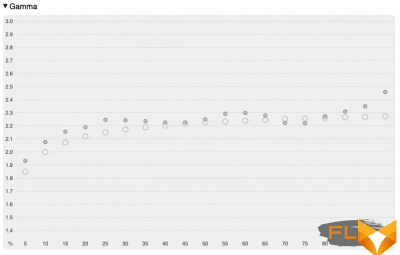 |
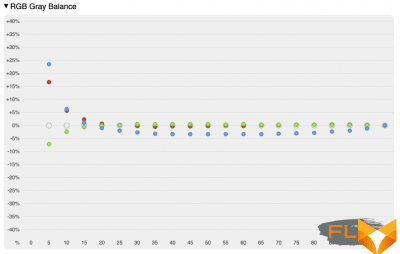 |
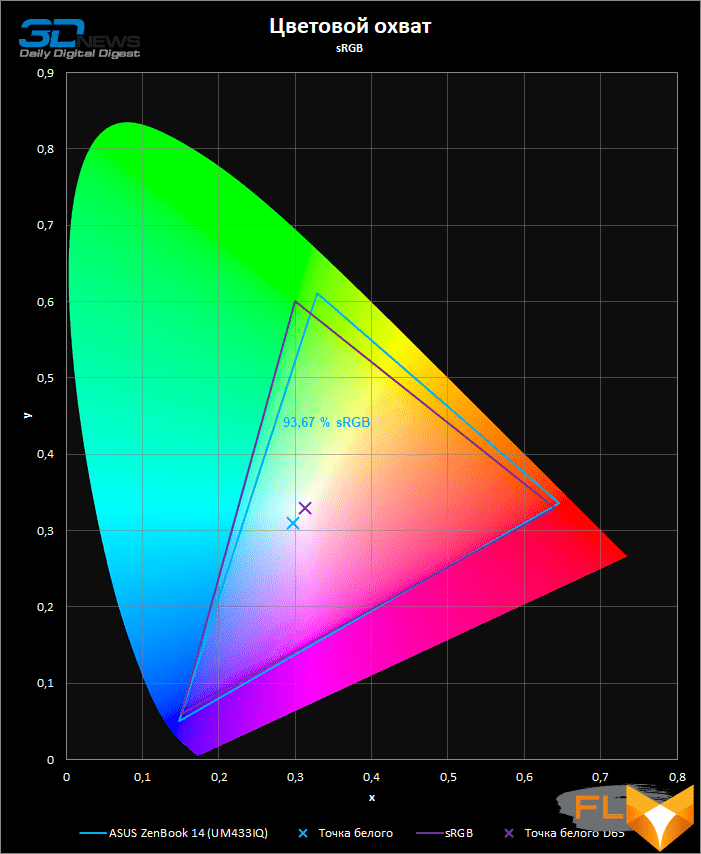

⇡#Clock speeds, temperature and noise level
As attractive as an eight-core processor in a lightweight ultrabook looks, it’s understandable to be skeptical about how laptop manufacturers will be able to provide adequate cooling and high enough power headroom to unleash the potential of the Ryzen 7 4700U. Indeed, according to the official specifications, this chip is allowed to consume up to 25 W to cover the entire frequency scale from 2 to 4.1 GHz, but ASUS had to impose restrictions on the power consumption of the chip. When fully loaded with eight cores, the power stabilizes around 19 watts, although instant jumps up to 30 are acceptable. Still, the ASUS ZenBook 14 UM433IQ CPU maintains amazingly high clock speeds: about 2.7 GHz on average and 3.4 GHz in the short term. For comparison: the closest analogue in terms of power consumption and clock speeds among Intel chips based on 14nm Comet Lake silicon in our database is the Core i7-10510U, but this is just a quad-core. Six-core Comet Lake in the same conditions reach 25 watts of power. Well, within the Ice Lake line, processors with more than four cores simply do not exist.
The fact is that the Ryzen 7 4700U chip here is significantly limited by the power reserve and does not consume more than 17 W of the 25 allowed by its passport specifications. As a result, at full load on all eight cores, the CPU clock speed fluctuates around a modest mark of 1.6 GHz, and if you put the cooling system into quiet mode using the MyASUS control program, it drops to 1.4 GHz.
As far as the GPU is concerned, the entry-level GeForce MX350 accelerator does not provide monitoring programs with information about the power consumption (as well as the temperature of the crystal during idle periods). But judging by the frequencies of the CPU and GPU, with a combined load, the laptop’s automation does not try to limit it in any way, and as a result, the central processor has to slow down to 1.4 GHz.
| Load Clock | ||||||||
|---|---|---|---|---|---|---|---|---|
| Cinebench R20 (Max Thread #) | LuxMark 3.1 | Cinebench R20 (Max Thread #) + LuxMark 3.1 | ||||||
| CPU clock speed, MHz | GPU clock speed, MHz | CPU clock speed, MHz | GPU clock speed, MHz | |||||
| Medium | Max | Medium | Max | Medium | Max | Medium | Max | |
| ASUS ZenBook 14 (UM433IQ) – AMD Ryzen 5 4700U / NVIDIA GeForce MX350 – Standard | 2694 | 3419 | 1321 | 1493 | 1409 | 1637 | 1301 | 1493 |
| ASUS ZenBook 14 (UM433IQ) — AMD Ryzen 5 4700U / NVIDIA GeForce MX350 — Whisper | 1727 | 1817 | 1238 | 1468 | 399 | 399 | 845 | 949 |
| CPU and GPU power | ||||||||
|---|---|---|---|---|---|---|---|---|
| Cinebench R20 (Max Thread #) | LuxMark 3.1 | Cinebench R20 (Max Thread #) + LuxMark 3.1 | ||||||
| CPU power consumption, W | GPU power consumption, W | CPU power consumption, W | GPU power consumption, W | |||||
| Medium | Max | Medium | Max | Medium | Max | Medium | Max | |
| ASUS ZenBook 14 (UM433IQ) – AMD Ryzen 5 4700U / NVIDIA GeForce MX350 – Standard | 19 | 30 | N/A | N/A | 10 | 10 | N/A | N/A |
| ASUS ZenBook 14 (UM433IQ) – AMD Ryzen 5 4700U / NVIDIA GeForce MX350 – Whisper | 10 | 10 | N/A | N/A | 7 | 7 | N/A | N/A |
Note The measurement is performed after the device has warmed up and all parameters have stabilized.
CPU power consumption of under 20W is not out of the ordinary for an ultrabook, and the CPU temperature in the new ZenBook 14 under maximum load does not exceed quite acceptable 84 °C. But to call the car a quiet language will not turn. If the user does not need the full power of eight cores running at the highest possible clock speeds in this configuration, it is better to enable Whisper mode in the MyASUS control program. Of course, then the average CPU clock speed in heavy applications will drop to 1.7 GHz, but again, it should be considered in the context of competing Intel offers. This is the standard on many Comet Lake and Ice Lake ultrabooks, only the AMD-powered ZenBook 14 offers twice as many cores and is virtually silent.
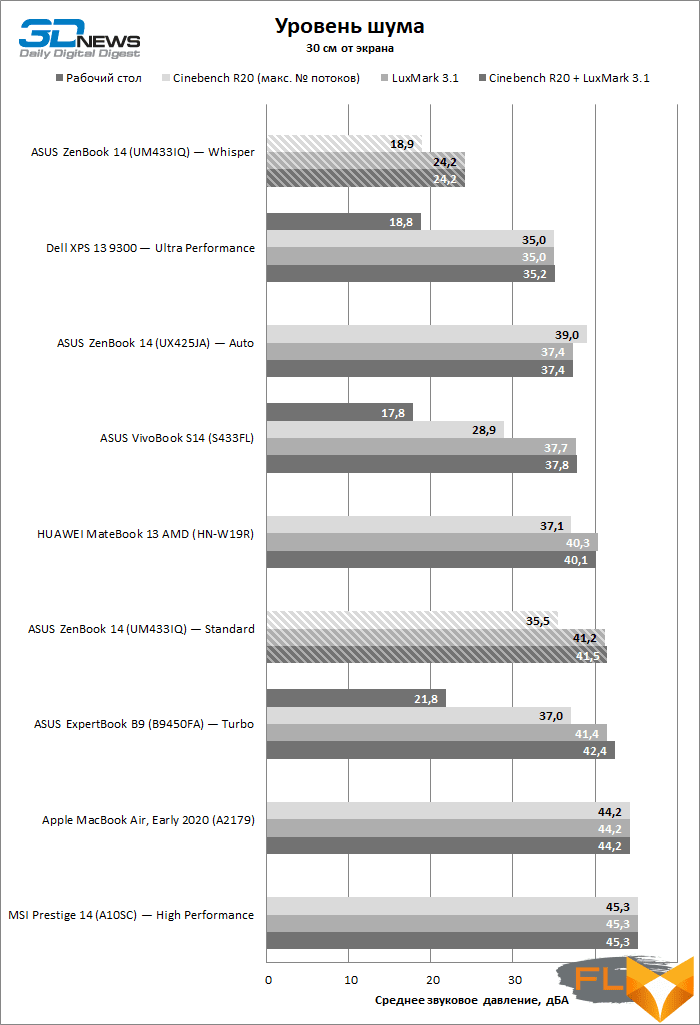
⇡#Synthetic Performance Tests
Ryzen 4000-series mobile processors have once again demonstrated their outstanding power efficiency. Intel simply doesn’t have eight-core offerings in its rival Comet Lake-U family, and even quad-core offerings among Ice Lake chips. But the main testament to the success of the Ryzen 7 4700U is that in terms of performance in a multi-threaded environment, it left behind the “blue” chips, which surpass it in power consumption by more than 30%. But in single-threaded mode, Intel still retains its leading position.

The GeForce MX350 is the strongest among today’s NVIDIA notebook video adapters, which are based on the formally obsolete Pascal architecture. However, preliminary tests did not reveal much difference between the MX350 and the next-largest model, the MX250. Both accelerators belong to the budget category and, by and large, are intended not so much for games, but for offloading the CPU in work applications, encoding/decoding video streams, and similar practical tasks. Nevertheless, in purely graphics tests, the GeForce MX350 is head and shoulders above any of the existing graphics options integrated into x86 processors, so it can also be considered quite a suitable solution for the most undemanding modern games.
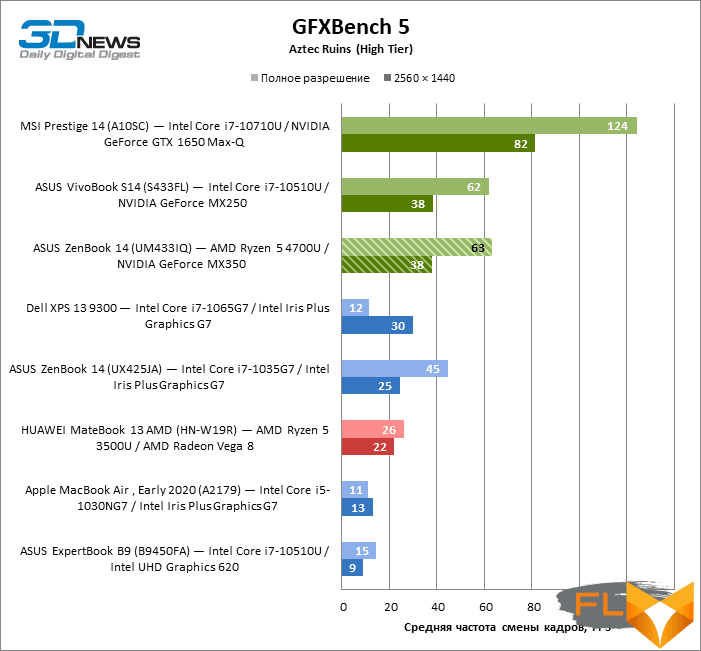
⇡#Performance in production applications
The ZenBook 14 Ryzen-based results in Blender raytracer complement the picture already painted by the Cinebench R20 synthetic benchmark, also based on tile rendering, an ideal working scenario for loading multi-core CPUs. Here, the Ryzen 7 4700U is the undisputed champion, which can only be approached by the overclocked six-core Core i7-1070U chip.
However, it is for 3D modeling that it is better to use discrete laptop graphics. Although the MX350 is not strong in gaming 3D rendering, in ray tracing tests it looks very good even against the background of the lower models of the GeForce 16 series, not to mention integrated accelerators.
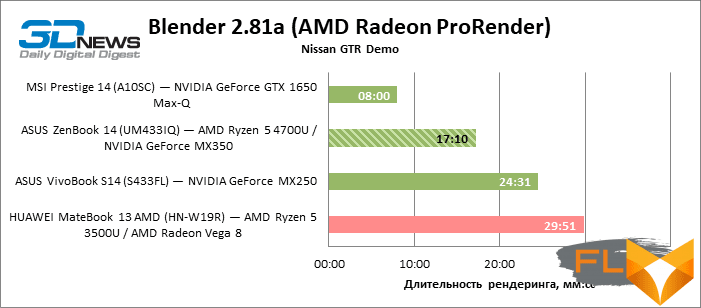
In the Photoshop Lightroom benchmark, which is nowhere near as CPU-intensive as Blender, but draws on the GPU, the “red” variant of the ZenBook 14 once again excelled at the top of the chart.
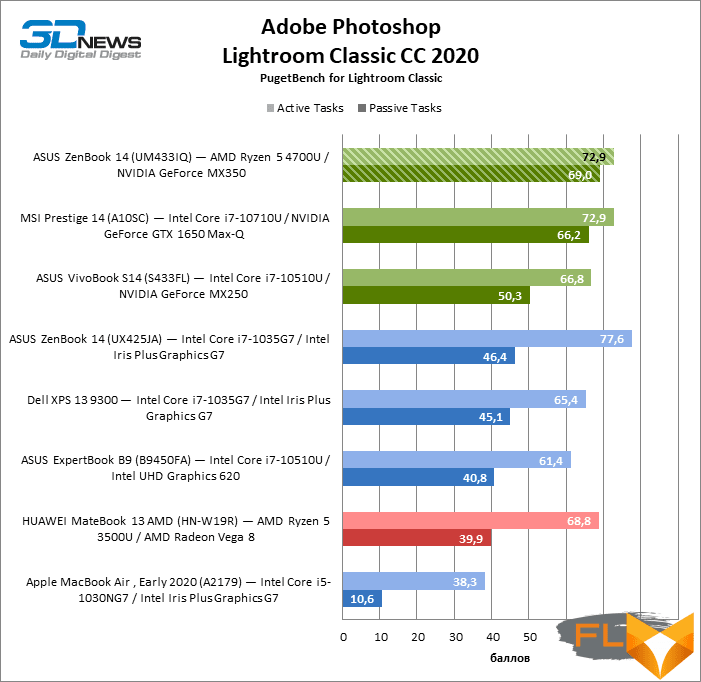
Note Scores are based on a percentage of the performance of a reference workstation with an Intel Core i9-9900K, NVIDIA GeForce RTX 2080, and 64GB RAM.
But in classic Photoshop, the novelty has lost its leading position, giving way to a laptop with an overclocked Core i7-1070U and relatively powerful discrete graphics GeForce GTX 1650 Max-Q. Not all operations in this photo editor are well parallelized into eight threads. As a result, Intel’s quad- and six-core processors running at higher clock speeds take advantage.
Note Scores are calculated as a percentage of the performance of a reference workstation with Intel Core i9-9900K, NVIDIA GeForce RTX 2080 and 64GB RAM times 10.
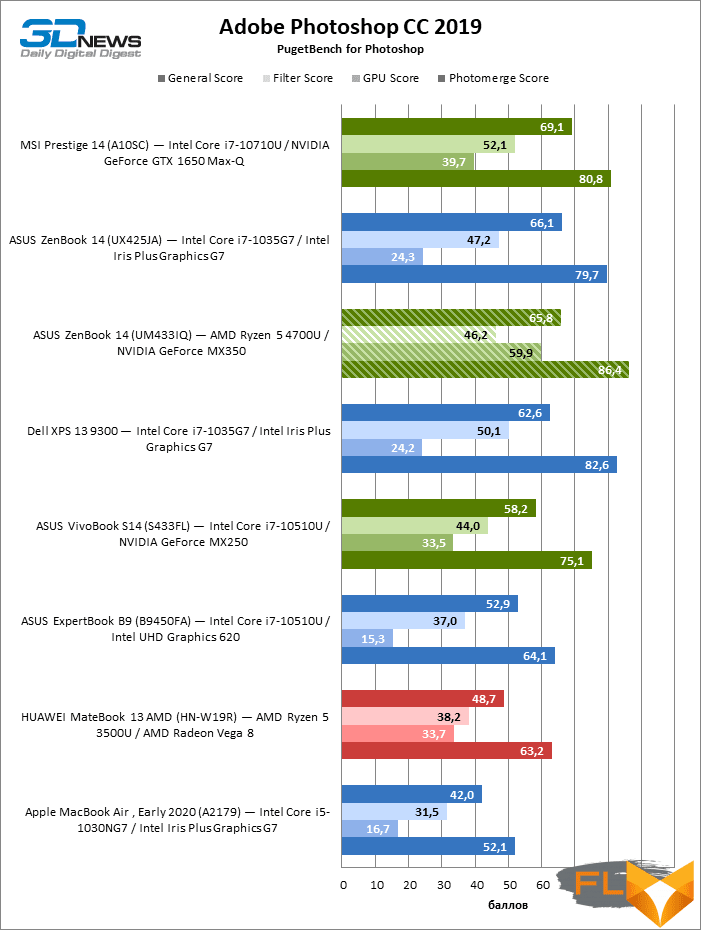
Note Scores are calculated as a percentage of the performance of a reference workstation with Intel Core i9-9900K, NVIDIA GeForce RTX 2080 and 64GB RAM.
This trend, unfortunately, continues in the Premiere Pro benchmarks. The ZenBook 14 on the Ryzen 7 4700U chip is far from a weak laptop of this size, but the additional two or even four processor cores did not give it a decisive advantage over its counterparts on Intel CPUs.
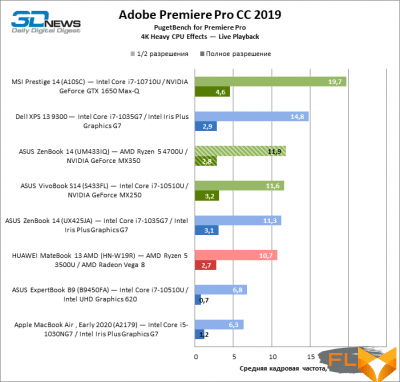 | 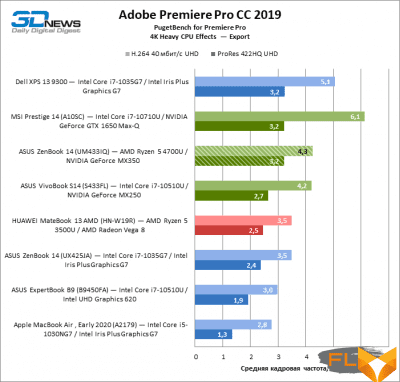 | |
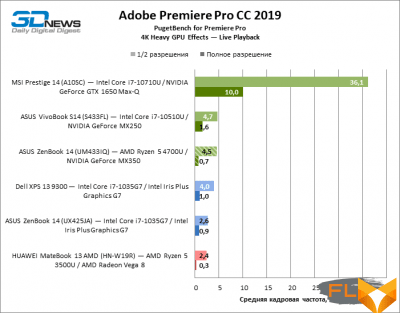 | 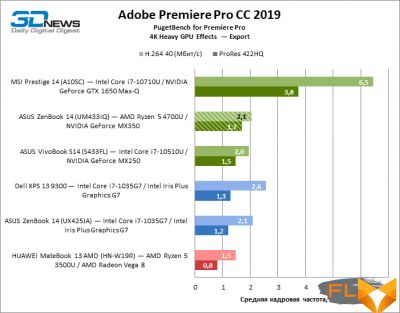 |
SSD performance
ASUS once again opted for an SSD branded Samsung PM981 for its new laptop. This is a well-deservedly popular drive, with some of the best performance of any SSD used in laptops, both with long and short command queues that dominate typical desktop tasks.
|
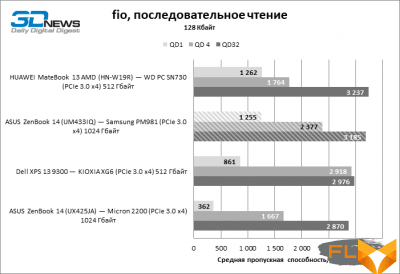 |
 | |
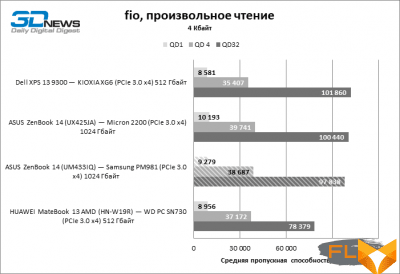 |
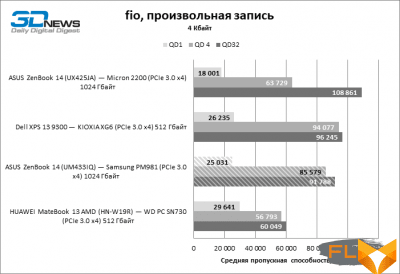 |
⇡#Battery Life
ASUS ZenBook 14 UM433IQ stands out among laptops similar in features and battery capacity, long battery life. You can count on the fact that the car will last at least 5 hours on the road with continuous video playback or almost 7 hours with active web surfing. True, there is one big but: the laptop dims the screen offline to 165 cd/m2, and we did not find a setting in either the BIOS or the control software that changes this behavior. As a result, directly comparing the ASUS ZenBook 14 UM433IQ with other laptops that can withstand a given brightness of 200 cd / m 2 in isolation from the outlet is still unfair.
⇡#Conclusions
The ASUS ZenBook 14 UM433IQ is a laptop that captures the main principle of AMD Ryzen 4000 series processors: more cores for the same money and with the same power consumption as similar Intel chips. Indeed, there is simply no such thing as eight-core ultrabooks based on the Intel platform (except for larger machines, such as the 16-inch MacBook Pro). And in the market category that owns the “red” version of the ZenBook 14, you usually can’t even count on six CPU cores, and even more so on eight, and even with not the weakest discrete graphics to boot. With the minimum price of the older UM433IQ configurations around $1,300, the characteristics of the novelty are impressive.
Another question is whether there is any tangible benefit from such an abundance of processor cores. Belonging to the class of ultrabooks due to the limited dimensions of these devices means a compromise between clock speeds, heating of components, noise from the cooling system and the weight of the computer. As tests have shown, the outstanding energy efficiency of the Ryzen 4000 is beyond doubt. Notebooks with quad- and six-core blue processors are not able to catch up with the ZenBook 14 UM433IQ in terms of speed, even in a variety of turbo modes that are not compatible with either silence or reasonable battery life. At the same time, it would be unfair of us to keep silent about the fact that even in the professional field, not all programs crave eight cores, and not high clock speeds. In such situations, the Ryzen 7 4700U is no better than its Intel counterparts. But the main thing is that it’s not worse, and taking into account the price advantage, AMD definitely wins.
However, the review of the ASUS ZenBook 14 UM433IQ laptop is on the agenda, not the Ryzen processor. We have no doubt that the seductive ratio between features and price can redeem in the eyes of buyers flaws in those aspects that are not directly related to the choice of CPU. But for those who are looking for a business laptop and sympathize with the red brand, you should still keep in mind that we are far from ideal. Like the other version of the ZenBook 14 we reviewed earlier, the UM433IQ looks great, plus it has a decent keyboard, but it has a very mediocre screen matrix, which is also not allowed by the BIOS to develop full brightness in standalone mode. In addition, the ZenBook 14’s CPU hardware unlocks its potential only at the cost of a high noise level, and the power consumption of the chip has absolutely nothing to do with it. Finally, opting for Ryzen means forgetting about Thunderbolt. But, we repeat, for such an amount and with such a filling, the ZenBook 14 UM433IQ still has few analogues, and this is its strength.
